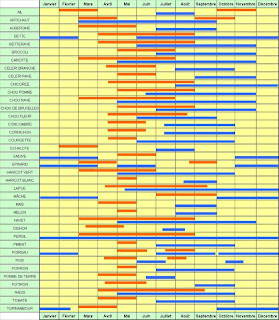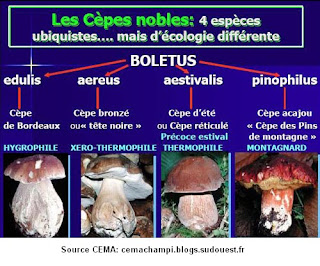Atelier Jardinage Durable dans un Climat Océanique


Sources :Table (http://www.benjaminbaudouin.com/) ; Map http://www.aujardin.info/fiches/climat_fr.php
Les défis du jardinage durable dans un climat océanique se présent avec un contraste accentué entre les étés chauds et les hivers rudes avec une brièveté entre les saisons de transition. En Fontainebleau, des hivers sont assez doux et des étés relativement frais, normalement les pluies sont fréquentes toute l'année. Calendrier du Jardinière[2]: Ce tableau donné à titre indicatif présente les périodes de semis pour les principaux légumes et temps des récoltes pour un climat océanique. Pour chaque espèce, il existe une grande diversité de variétés adaptées à différentes périodes de culture.
Un potager bio - C'est possible, voir:- Permaculture Guru: Bill Morrison (http://fr.wikipedia.org/wiki/Bill_Mollison )
- Témoignage alarmant de Claude Bourguignon, ex-agronome de l'INRA, sur l'état des sols en Europe et le risque de l'agriculture chimique pour la terre et le vivant (sur you tube : http://www.dailymotion.com/video/x3okjs_alerte-la-terre-est-malade_events )
- Vidéos de Biau Germe (http://www.imineo.com/biau-germe-dvd-17217.htm)
- Livre : La potagère anti-crise, Mangée sain en dépensant peu (Rodolphe Grosleziat)
- Blogs (http://www.tinkuy-blog.com/pages/Dossier_Jardin_ecolo_et_potager_bio-1443309.html )
- Associations (http://asso.permaculture.fr/ , http://www.kokopelli.asso.fr/ )
- Faire un plan potager (Elaborez le en hiver pour pouvoir y réfléchir et les modifier avant les premières plantations, selon le météo, Espacement de plants, …)
- Prévoir :
- Plants et Semences, …
- Equipements (Pour travaillé du e sol,…)
- Arrosage (Source, quantité, qualité, …)
- Tuteurs (Autres plants, supports, …)
- Fertilisation (Compostage, Engrais verts, Purins végétaux, …)
- Maladies et Insectes (Plants protectrices, Purins végétaux, …)
- Votre Agenda (Vos vacances, temps disponible par jour, …)
- Tenez compte de :
- familles de légume (feuille, fleurs, fruits, racines)
- la rotation des cultures (solanacées en particulaire, …)
- gênes éventuelles entre les légumes (ombre, nutriments, eau…)
- le côté pratique (pour ramasser et arroser vos légumes, des allées…)
- Légume associations bénéfiques associations
§ Par exemple, en utilisant un système Inter-plantation à l'Américaine Indienne, également connu sous le nom des Trois Sœurs vos pouvais tuteur vos haricots avec du mais et bénéficiées des propriétés fertilisant des haricots pour nourrir le sol, …)
A Story of Three Inseparable Sisters,…[1]
According to Iroquois legend, maize, beans, and squash are three inseparable sisters who only grow and thrive together. This tradition of inter-planting maize, beans and squash in the same mounds, widespread among Native American farming societies, is a sophisticated, sustainable system that provided long-term soil fertility and a healthy diet to generations. Growing a Three Sisters garden is a wonderful way to feel more connected to our food most of which was adopted from America.
Success with a Three Sisters garden involves careful attention to timing, seed spacing, and varieties. In many areas, if you simply plant all three in the same hole at the same time, the result will be a snarl of vines in which the maize gets overwhelmed!
Maize provides a natural pole for bean vines to climb. Beans fix nitrogen on their roots, improving the overall fertility of the plot by providing nitrogen to the following year’s maize. Bean vines also help stabilize the maize plants, making them less vulnerable to blowing over in the wind. Shallow-rooted squash vines become a living mulch, shading emerging weeds and preventing soil moisture from evaporating, thereby improving the overall crops chances of survival in dry years. Spiny squash plants also help discourage predators from approaching the maize and beans. The large amount of crop residue from this planting combination can be incorporated back into the soil at the end of the season, to build up the organic matter and improve its structure.
Maize, beans and squash also complement each other nutritionally. Maize provides carbohydrates, the dried beans are rich in protein, balancing the lack of necessary amino acids found in maize. Finally, squash yields both vitamins from the fruit and healthful, delicious oil from the seeds.
Native Americans kept this system in practice for centuries without the modern conceptual vocabulary we use today, i.e. soil nitrogen, vitamins, etc. They often look for signs in their environment that indicate the right soil temperature and weather for planting maize, you to may wish to record such signs as you observe in your garden and neighbourhood so that, depending on how well you judged the timing, you can watch for them again next season!
Seeds and Plants to realise your
Three Sister Garden are available, for 20€!!
3 butternut plants + 21 maize seeds
+ 3 pumpkin plants + 14 green bean seeds
+ 3 courgette plants + 14 bean seeds
Planting Season from late April to early June


Comments
Post a Comment